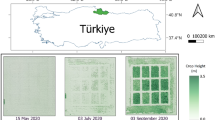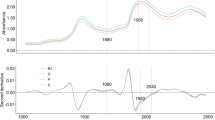Abstract
To address issues relating to the advantages of varieties of sorghum in construction, breeding, and brewing of the seed repository, a visible–near-infrared hyperspectral imaging (VNIR-HSI) non-destructive technique was proposed to detect different varieties of sorghum. The VNIR-HSI system was used to collect spectrum images for 27 types of varieties of sorghum, and the spectral data were pre-processed using Savitzky–Golay (S–G) smoothing filters, the standard normal variate (SNV), and multiplicative scatter correction (MSC). Competitive adaptive reweighted sampling (CARS) was used for dimensionality reduction. Based on full-spectrum and characteristic spectral data, classification models were developed using a random forest (RF) algorithm. The tested results indicated that precisions of calibration and prediction sets of the RF model established based on the full-spectrum reach 94.58% and 64.44%, respectively. The CARS algorithm was adopted to extract 20 characteristic wavelengths from sorghum spectra. The precisions of the calibration and prediction sets for the CARS-RF model reach 95.00% and 84.07%, respectively. Using the confusion matrix to calculate Cohen's kappa values, the calibration and prediction Cohen's kappa values for the full sample were 0.9212 and 0.9231 respectively, indicating that the evaluation results are almost identical to the correctness results. The applied model can achieve favorable effects when detecting each cultivar of sorghum. The results show that the modeling method integrating VNIR-HSI technique with CARS-RF can provide a rapid non-destructive testing method for detection of varieties of sorghum, and offer an idea for detecting cultivars of coarse cereal crops.







Similar content being viewed by others
Data availability
Available upon request from the corresponding author.
References
Lopes MS, Araus JL, Van Heerden PDR et al (2011) Enhancing drought tolerance in C4 crops. J Exp Bot 62(9):3135–3153. https://doi.org/10.1093/jxb/err105
Wang Y, Chan KX, Long SP et al (2021) Towards a dynamic photosynthesis model to guide yield improvement in C4 crops. Plant J 107(2):343–359. https://doi.org/10.1111/tpj.15408
Khoddami A, Messina V, Vadabalija Venkata K et al (2021) Sorghum in foods: Functionality and potential in innovative products. Crit Rev Food Sci Nutr 2021:1–17. https://doi.org/10.1080/10408398.2021.1960793
Hao H, Li Z, Leng C et al (2021) Sorghum breeding in the genomic era: opportunities and challenges. Theor Appl Genet 134:1899–1924. https://doi.org/10.1007/s00122-021-03789-z
Mayor L, Demarco P, Lira S et al (2023) Retrospective study in US commercial sorghum breeding: I. Genetic gain in relation to relative maturity. Crop Sci 63(2):501–510. https://doi.org/10.1002/csc2.20897
Dabija A, Ciocan ME, Chetrariu A et al (2021) Maize and sorghum as raw materials for brewing, a review. Appl Sci 11(7):3139. https://doi.org/10.3390/app11073139
Shehzad T, Okuizumi H, Kawase M et al (2009) Development of SSR-based sorghum (Sorghum bicolor (L.) Moench) diversity research set of germplasm and its evaluation by morphological traits. Genet Resour Crop Evol 56:809–827. https://doi.org/10.1007/s10722-008-9403-1
Kaur B, Sandhu KS, Kamal R et al (2021) Omics for the improvement of abiotic, biotic, and agronomic traits in major cereal crops: applications, challenges, and prospects. Plants 10(10):1989. https://doi.org/10.3390/plants10101989
Endalamaw C, Adugna A, Mohammed H (2017) Correlation and path coefficient analysis of agronomic and quality traits in a bioenergy crop, sweet sorghum [Sorghum bicolor (L.) Moench]. Afr J Biotechnol 16(47):2189–2200. https://doi.org/10.5897/AJB2017.16241
Cong S, Liu C, Zhu Z et al (2021) Study on identification of multiple pesticide residues in lettuce leaves based on hyperspectral technology. In: Advances in artificial intelligence and security: 7th international conference, ICAIS 2021, Dublin, Ireland, July 19–23, 2021, proceedings, Part III 7. Springer International Publishing, pp 537–550. https://doi.org/10.1007/978-3-030-78621-2_45
Jun S, Xin Z, Hanping M et al (2016) Identification of pesticide residue level in lettuce based on hyperspectra and chlorophyll fluorescence spectra. Int J Agric Biol Eng 9(6):231–239. https://doi.org/10.3965/j.ijabe.20160906.2519
Belmerhnia L, Djermoune EH, Carteret C et al (2021) Simultaneous variable selection for the classification of near infrared spectra. Chemom Intell Lab Syst 211:104268. https://doi.org/10.1016/j.chemolab.2021.104268
Song XZ, Tang G, Zhang LD et al (2017) Research advance of variable selection algorithms in near infrared spectroscopy analysis. Spectrosc Spectr Anal 37(4):1048–1052. https://doi.org/10.3964/j.issn.1000-0593(2017)04-1048-05
Zhu J, Li H, Rao Z et al (2023) Identification of slightly sprouted wheat kernels using hyperspectral imaging technology and different deep convolutional neural networks. Food Control 143:109291. https://doi.org/10.1016/j.foodcont.2022.109291
Yang H, Cheng Y, Li G (2021) A denoising method for ship radiated noise based on Spearman variational mode decomposition, spatial-dependence recurrence sample entropy, improved wavelet threshold denoising, and Savitzky–Golay filter. Alex Eng J 60(3):3379–3400. https://doi.org/10.1016/j.aej.2021.01.055
Kabir MH, Guindo ML, Chen R et al (2021) Geographic origin discrimination of millet using Vis–NIR spectroscopy combined with machine learning techniques. Foods 10(11):2767. https://doi.org/10.3390/foods10112767
Song X, Du G, Li Q et al (2020) Rapid spectral analysis of agro-products using an optimal strategy: dynamic backward interval PLS-competitive adaptive reweighted sampling. Anal Bioanal Chem 412:2795–2804. https://doi.org/10.1007/s00216-020-02506-x
Chen Y, Cao R, Chen J et al (2021) A practical approach to reconstruct high-quality Landsat NDVI time-series data by gap filling and the Savitzky–Golay filter. ISPRS J Photogramm Remote Sens 180:174–190. https://doi.org/10.1016/j.isprsjprs.2021.08.015
Mishra P, Marini F, Biancolillo A et al (2021) Improved prediction of fuel properties with near-infrared spectroscopy using a complementary sequential fusion of scatter correction techniques. Talanta 223:121693. https://doi.org/10.1016/j.talanta.2020.121693
Wrobel TP, Liberda D, Koziol P et al (2020) Comparison of the new Mie extinction extended multiplicative scattering correction and resonant mie extended multiplicative scattering correction in transmission infrared tissue image scattering correction. Infrared Phys Technol 107:103291. https://doi.org/10.1016/j.infrared.2020.103291
Mishra P, Rutledge DN, Roger JM et al (2021) Chemometric pre-processing can negatively affect the performance of near-infrared spectroscopy models for fruit quality prediction. Talanta 229:122303. https://doi.org/10.1016/j.talanta.2021.122303
Zhang Z, Ding J, Zhu C et al (2020) Combination of efficient signal pre-processing and optimal band combination algorithm to predict soil organic matter through visible and near-infrared spectra. Spectrochim Acta Part A Mol Biomol Spectrosc 240:118553. https://doi.org/10.1016/j.saa.2020.118553
Tang H, Meng X, Su X et al (2021) Hyperspectral prediction on soil organic matter of different types using CARS algorithm. Trans CSAE 37:105–113. https://doi.org/10.11975/j.issn.1002-6819.2021.2.013
Lennon JT, den Hollander F, Wilke-Berenguer M et al (2021) Principles of seed banks and the emergence of complexity from dormancy. Nat Commun 12(1):4807. https://doi.org/10.1038/s41467-021-24733-1
Liu J, Dong Z, Xia J et al (2021) Estimation of soil organic matter content based on CARS algorithm coupled with random forest. Spectrochim Acta Part A Mol Biomol Spectrosc 258:119823. https://doi.org/10.1016/j.saa.2021.119823
Liu J, Jin S, Bao C et al (2021) Rapid determination of lignocellulose in corn stover based on near-infrared reflectance spectroscopy and chemometrics methods. Biores Technol 321:124449. https://doi.org/10.1016/j.biortech.2020.124449
Bai Z, Hu X, Tian J et al (2020) Rapid and nondestructive detection of sorghum adulteration using optimization algorithms and hyperspectral imaging. Food Chem 331:127290. https://doi.org/10.1016/j.foodchem.2020.127290
Huang H, Hu X, Tian J et al (2021) Rapid and nondestructive prediction of amylose and amylopectin contents in sorghum based on hyperspectral imaging. Food Chem 359:129954. https://doi.org/10.1016/j.foodchem.2021.129954
Caporaso N, Whitworth MB, Fisk ID (2018) Near-Infrared spectroscopy and hyperspectral imaging for non-destructive quality assessment of cereal grains. Appl Spectrosc Rev 53(8):667–687. https://doi.org/10.1080/05704928.2018.1425214
Wang C, Wu XH, Li LQ et al (2018) Convolutional neural network application in prediction of soil moisture content. Spectrosc Spect Anal 38(1):36–41. https://doi.org/10.3964/j.issn.1000-0593(2018)01-0036-06
Georganos S, Grippa T, Niang Gadiaga A et al (2021) Geographical random forests: a spatial extension of the random forest algorithm to address spatial heterogeneity in remote sensing and population modelling. Geocarto Int 36(2):121–136. https://doi.org/10.1080/10106049.2019.1595177
Dhanaraj RK, Ramakrishnan V, Poongodi M et al (2021) Random forest bagging and x-means clustered antipattern detection from sql query log for accessing secure mobile data. Wirel Commun Mob Comput 2021:1–9. https://doi.org/10.1155/2021/2730246
Sheykhmousa M, Mahdianpari M, Ghanbari H et al (2020) Support vector machine versus random forest for remote sensing image classification: a meta-analysis and systematic review. IEEE J Select Top Appl Earth Observ Remote Sens 13:6308–6325. https://doi.org/10.1109/JSTARS.2020.3026724
Gano B, Dembele JSB, Ndour A et al (2021) Using uav borne, multi-spectral imaging for the field phenotyping of shoot biomass, leaf area index and height of West African sorghum varieties under two contrasted water conditions. Agronomy 11(5):850. https://doi.org/10.3390/agronomy11050850
Wang K, Guo P, Luo AL (2017) A new automated spectral feature extraction method and its application in spectral classification and defective spectra recovery. Mon Not R Astron Soc 465(4):4311–4324. https://doi.org/10.1093/mnras/stw2894
Indahl UG, Naes T (1998) Evaluation of alternative spectral feature extraction methods of textural images for multivariate modelling. J Chemometr J Chemometr Soc 12(4):261–278. https://doi.org/10.1002/(SICI)1099-128X(199807/08)12:4%3c261::AID-CEM513%3e3.0.CO;2-Z
Sun L, Zhao G, Zheng Y et al (2022) Spectral–spatial feature tokenization transformer for hyperspectral image classification. IEEE Trans Geosci Remote Sens 60:1–14. https://doi.org/10.1109/TGRS.2022.3144158
Wang N, Yao D, Ma L et al (2021) Multi-site clustering and nested feature extraction for identifying autism spectrum disorder with resting-state fMRI. Med Image Anal 75:102279. https://doi.org/10.1016/j.media.2021.102279
Sun Y, Liu B, Yu X et al (2021) Perceiving spectral variation: unsupervised spectrum motion feature learning for hyperspectral image classification. IEEE Trans Geosci Remote Sens 60:1–17. https://doi.org/10.1109/TGRS.2022.3221534
Cheng Z, Zhang LQ et al (2010) Successive projections algorithm and its application to selecting the wheat near infrared spectral variables. Spectrosc Spectr Anal 30(4):949–952. https://doi.org/10.3964/j.issn.1000-0593(2010)04-0949-04
Funding
This work was supported by Major Special Projects of National Key R&D, grant number 2021YFD1600301-4; Major Special Projects of Shanxi Province Key R&D, grant number 202102140601013; Major Special Projects of Shanxi Province Key R&D, grant number 201903D211005.
Author information
Authors and Affiliations
Contributions
Conceptualization, KW; methodology, KW, TZ and XZ; investigation, MY, ZW, and DL; writing—original draft, KW; writing—review and editing, KW and ZL. All authors have read and agreed to the published version of the manuscript.
Corresponding author
Ethics declarations
Conflict of interest
The authors declare no conflict of interests. The funders have no role in the experimental design, data collection and analysis, decision to publish, or preparation of the manuscript.
Compliance with ethics requirements
This article does not contain any studies with human or animal subjects.
Additional information
Publisher's Note
Springer Nature remains neutral with regard to jurisdictional claims in published maps and institutional affiliations.
Rights and permissions
Springer Nature or its licensor (e.g. a society or other partner) holds exclusive rights to this article under a publishing agreement with the author(s) or other rightsholder(s); author self-archiving of the accepted manuscript version of this article is solely governed by the terms of such publishing agreement and applicable law.
About this article
Cite this article
Wu, K., Zhu, T., Wang, Z. et al. Identification of varieties of sorghum based on a competitive adaptive reweighted sampling-random forest process. Eur Food Res Technol 250, 191–201 (2024). https://doi.org/10.1007/s00217-023-04377-9
Received:
Revised:
Accepted:
Published:
Issue Date:
DOI: https://doi.org/10.1007/s00217-023-04377-9




